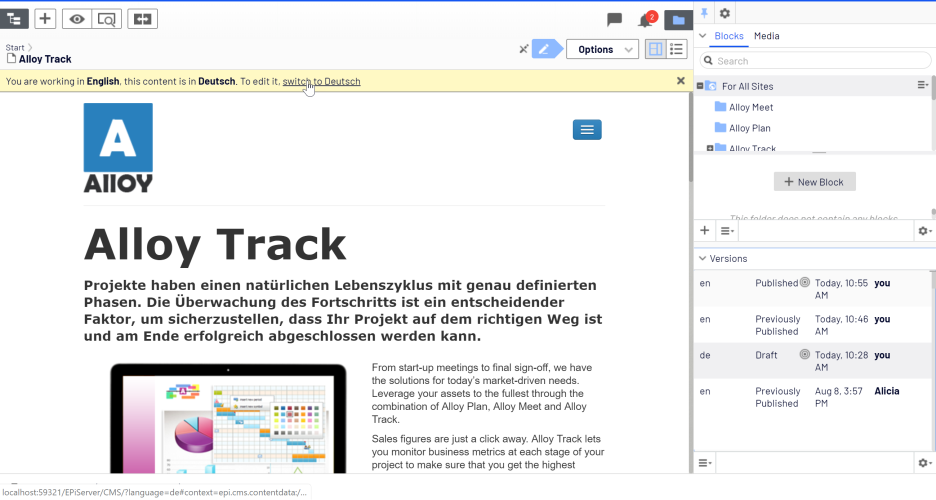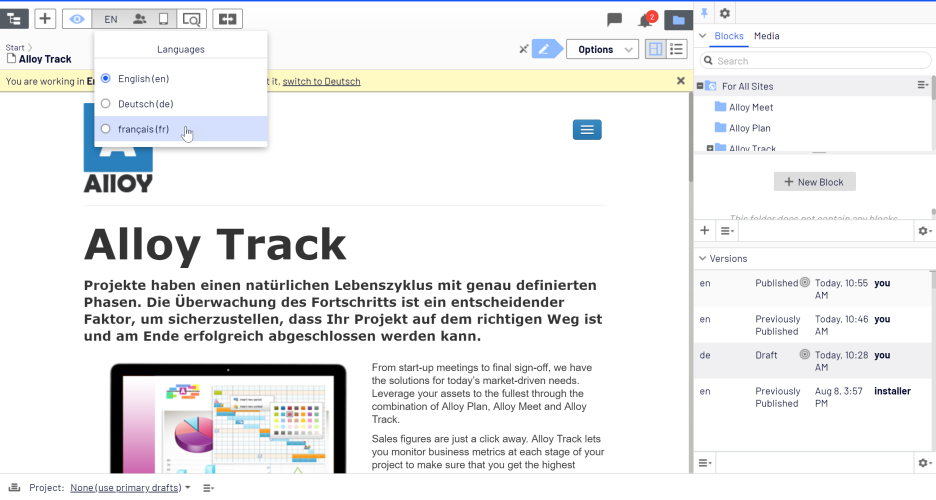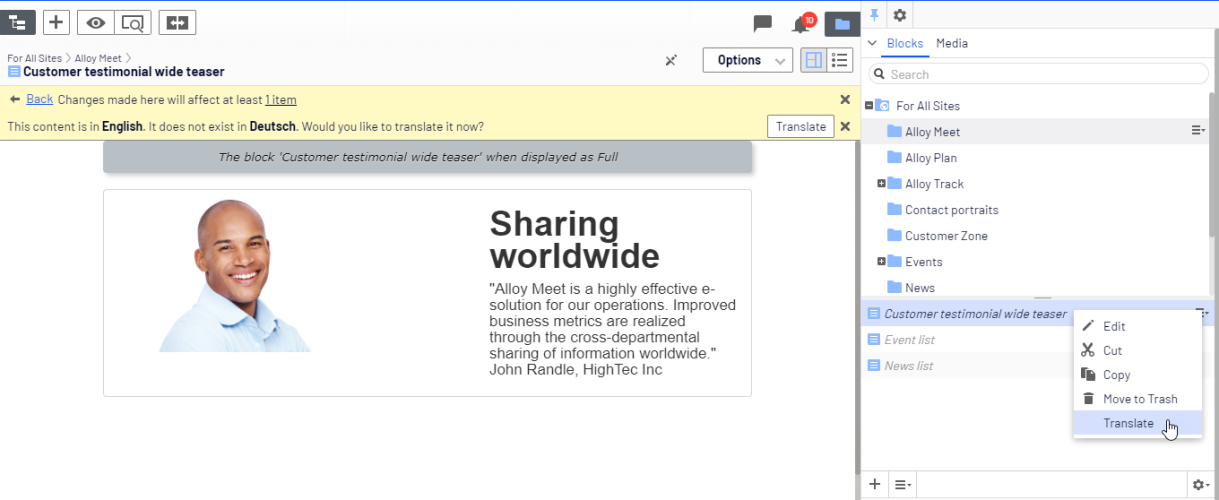 Translating content
Translating content
When an administrator has enabled the desired language, you are ready to translate existing content, or create new content in a specific language. Content here can be, for example, pages or blocks on an Optimizely CMS website, or product-related content on an e-commerce site. When a language is enabled in Optimizely, content properties that are not global are available for translation. See also Global properties.
To prevent editors from accidentally creating content in the wrong language, access rights can be set differently for different languages by an administrator. If this is implemented, you can only edit and create content in languages to which you have access.
See also the Optimizely Languages add-on to extend the functionality in Optimizely for translating content into multiple languages.
Switching language and viewing language versions
To switch language in CMS, go to the Sites tab in the navigation pane and select the desired language to work with. The user interface reloads, displaying the page tree in the selected language.
If your master language The language in which the first version of content is created. is English and you switch to German, all pages that are not yet translated into German are displayed in italics in the page tree and with the en language code for English. Pages that exist in German are displayed in normal font.
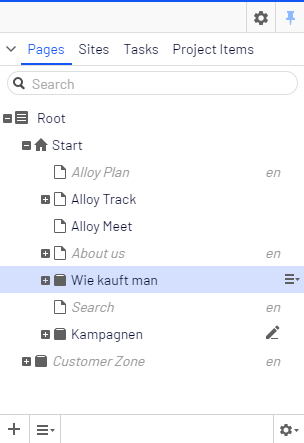
To view only pages that were translated, select Show Content in Current Language Only from the page tree's Settings button. This filters out all other language versions. You can also use this option in the assets pane and in the Versions gadget to view blocks and versions in the current language only.
When you show content in one language only, you can move pages to another location in the page tree structure by drag and drop or copy and paste, but it is not possible to sort pages. Sorting is disabled since sorting in one language, where you may not see all pages, can cause unexpected results in other languages.
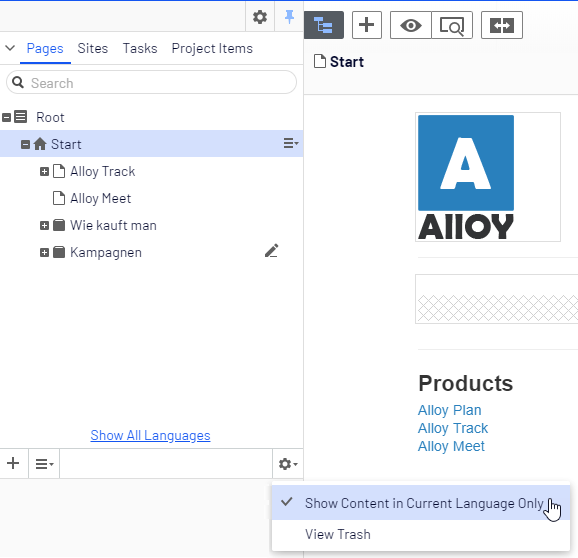
The setting Show Content in Current Language Only is enabled for each pane or gadget instance individually. This means that you, for example, can add the Versions gadget twice and display only the current language in one of the instances and all languages in the other.
You can also switch languages by selecting the desired language in the Header, when editing translated content in the All Properties view. The user interface reloads, displaying the content in the selected language.
When you translate content, you can use the Versions gadget to see the different language versions for the content. By selecting a language in the version list, you can also switch to editing in another language using the switch option in the notification bar.
You can search for all language versions for some content by typing a keyword in the search field for Pages or Blocks in the assets pane.
Previewing content in different languages
Using the view settings  in the top menu, you can preview and edit content in one of the languages that are available for translation on the website.
in the top menu, you can preview and edit content in one of the languages that are available for translation on the website.
Deleting language versions
To delete one or more language versions for content, select Delete Version or Delete All [language] Versions from the More options button in the Versions gadget.
Deleting one or more language versions cannot be undone.
Translating existing content
The Sites tab displays the languages available for content creation, with the default language for the website at the top. Languages that are enabled on the website but are not enabled for editing, are shown in italics.
Translating a page
By default, all pages in the tree structure are displayed in the Pages tab, including those that are not translated. These are shown in italics. To only see pages for the chosen language, select Show Content in Current Language Only.
Do the following to translate a page:
- Under the Sites tab in the navigation pane, select the desired target language for translation. The interface reloads, and you are taken to the Pages tab.
- In the page tree, select the desired page to translate, and then click Translate in the notification bar at the top. Or, select Translate in the context menu for the page in the page tree.
- You can use the compare view
 to translate in one pane while seeing the original version in the other pane at the same time.
to translate in one pane while seeing the original version in the other pane at the same time. - Edit the content and follow the content publishing flow to save and publish the translated page.
Translating a block
You can access language versions for blocks from Blocks in the assets pane. By default, all blocks are displayed, including those that are not translated; these are shown in italics. To only see blocks for the chosen language, select Show Content in Current Language Only.
To translate a block:
- Under the Sites tab in the navigation pane, select the desired target language for translation, and the interface reloads.
- Expand the assets pane and select Blocks.
- In the block structure, select the desired block to translate, and then the Translate option in the context menu.
- You can use the compare view
 to translate in one pane while seeing the original version in the other pane at the same time.
to translate in one pane while seeing the original version in the other pane at the same time. - Edit the content and follow the content publishing flow to save and publish the translated block.
Global properties
Depending on your implementation, some properties may be globally shared and you can edit them in the master language The language in which the first version of content is created.. These properties are marked as non-editable when editing the content in another language. Switch to the default language if you need to edit these. The default language is usually the first language listed next to Languages in the header when editing in the All Properties view.
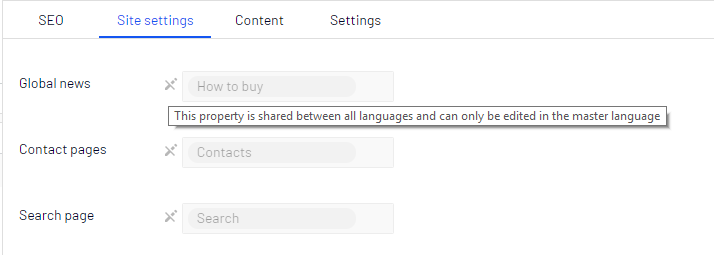
Creating new content in another language
To create content in a language other than the master language, select the desired language under the Sites tab. Then select the page branch or folder where you want to create the content, and create a new page or a new block. Add content and follow the content publishing flow to save and publish.
 Optimizely Commerce and multiple languages
Optimizely Commerce and multiple languages
See Multi-language management in the Optimizely Commerce
